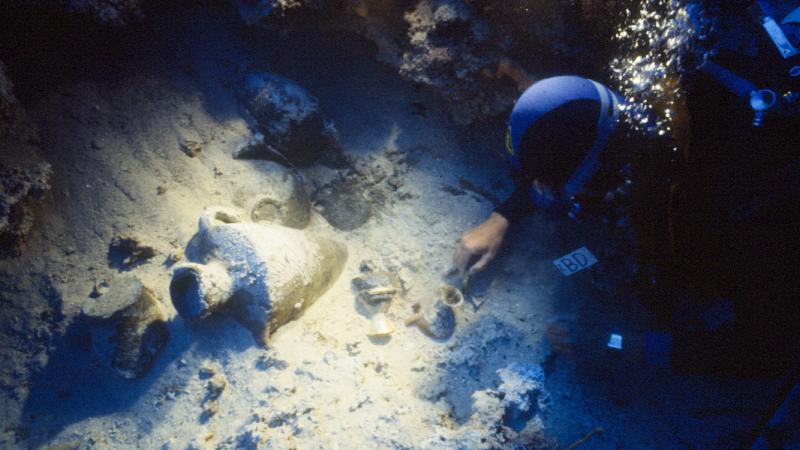Shakespeare’s First Folio goes on a tour of America in 2016—to museums, universities, libraries, historical societies, and a theater—one location each in the 50 states, Puerto Rico, and Washington, D.C.
Called “First Folio! The Book That Gave Us Shakespeare,” this unique exhibition marks the 400th anniversary of William Shakespeare’s death in 1616. It’s only the latest way in which NEH-supported projects have brought Americans closer to Shakespeare and his works.
The First Folio has a unique place in history and literature. Published in 1623, seven years after Shakespeare’s death, it includes 36 of his plays—18 of which were previously unpublished. Without it, such masterpieces as Macbeth and The Tempest would have been lost.
By far the largest collection of First Folios in the world—82 in all—is at the Folger Shakespeare Library in Washington, D.C. The Folger organized the tour, supported by $500,000 from NEH, in partnership with the American Library Association and the Cincinnati Museum Center. Every stop will include Shakespeare-related public programs and events.
NEH has also provided $3,375,472 for a very different Folger project on classroom education. For 31 years, teachers from across the country have traveled to Washington for an intensive monthlong Teaching Shakespeare Institute centered on the Folger’s time-tested approach to connecting students with Shakespeare.
The institutes have had a lasting, powerful effect on the 775 teachers who have participated and their students. (Lesson plans for several of the plays are also gathered in a three-volume set, Shakespeare Set Free.) Looking back in 2014, Mary Bevilacqua, who attended the institute in 1991, put its impact in a nutshell. Bevilacqua taught English for three decades in Florida. Her high school students, she told the Folger, “ran to class when we read Shakespeare, and years later they tell me how he continues to enrich their lives.”
The Folger, which has the world’s largest Shakespeare collection, also received $119,598 from NEH for the Shakespeare Quartos Archive, a digital humanities initiative led by the Folger and the University of Oxford. The project focused on quartos—rare, very early one-play editions of some of Shakespeare’s works that were published during or just after his lifetime. Because they were slender, cheap editions, only a small number survive, offering intriguing, sometimes odd, variations in the familiar texts. A famously clunky line from the 1603 first quarto of Hamlet, for example, reads “To sleepe, to dreame, I mary there it goes.”
As a milestone prototype project, the SQA brought together 32 Hamlet quartos from six different institutions in the United States and United Kingdom. Each quarto was digitized, transcribed, and—after the site's launch in 2009—made available from cover to cover to anyone with an Internet connection.
About 150 miles southwest of the Folger, in Staunton, Virginia, the American Shakespeare Center (ASC) may be best known for its stunning indoor stage, a careful recreation of the Blackfriars Theatre, where Shakespeare’s plays were produced in his lifetime. Home to multiple productions a year, the Virginia theater is simultaneously a popular theater and a place to explore the staging practices of the sixteenth century. One obvious—and important—difference from today: Both the stage and the audience have the same lighting, drawing audiences into the action.
ASC director Ralph Cohen says the center can trace its current location and success to a $189,000 grant from NEH in 1993 for a summer institute on “Renaissance and Shakespearean Staging.” The institute aimed to close the gap between academia and theater practitioners, with illuminating results.
Twenty-five professors of theater and English attended that first cross-disciplinary institute and spread the word enthusiastically. That institute also led the organization to its new home in Staunton. And that, summarizes Cohen, is “why I love NEH. They took a chance on us” when that funding made all the difference.
Reaching still more audiences, the WNET public television series Shakespeare Uncovered, made possible with $500,000 from NEH, explores the stories and ideas behind the plays. In its two seasons so far, famous guides such as Ethan Hawke, Morgan Freeman, and Kim Cattrall invite viewers into the worlds of the plays—Macbeth for Hawke, The Taming of the Shrew for Freeman, and Antony and Cleopatra for Cattrall—through conversations with directors and researchers, rehearsals, wide-ranging locations, and their own perspectives.
“When you think of violent murders, brutal crimes, and nightmarish horrors,” says Hawke, “You might think of a big city. You might think of Manhattan. Or, if you’re like me, you might think a little bit past that, to about a 400-year-old play, named Macbeth.”
Written by Esther Ferington, an editor, writer, and content developer in Northern Virginia.


